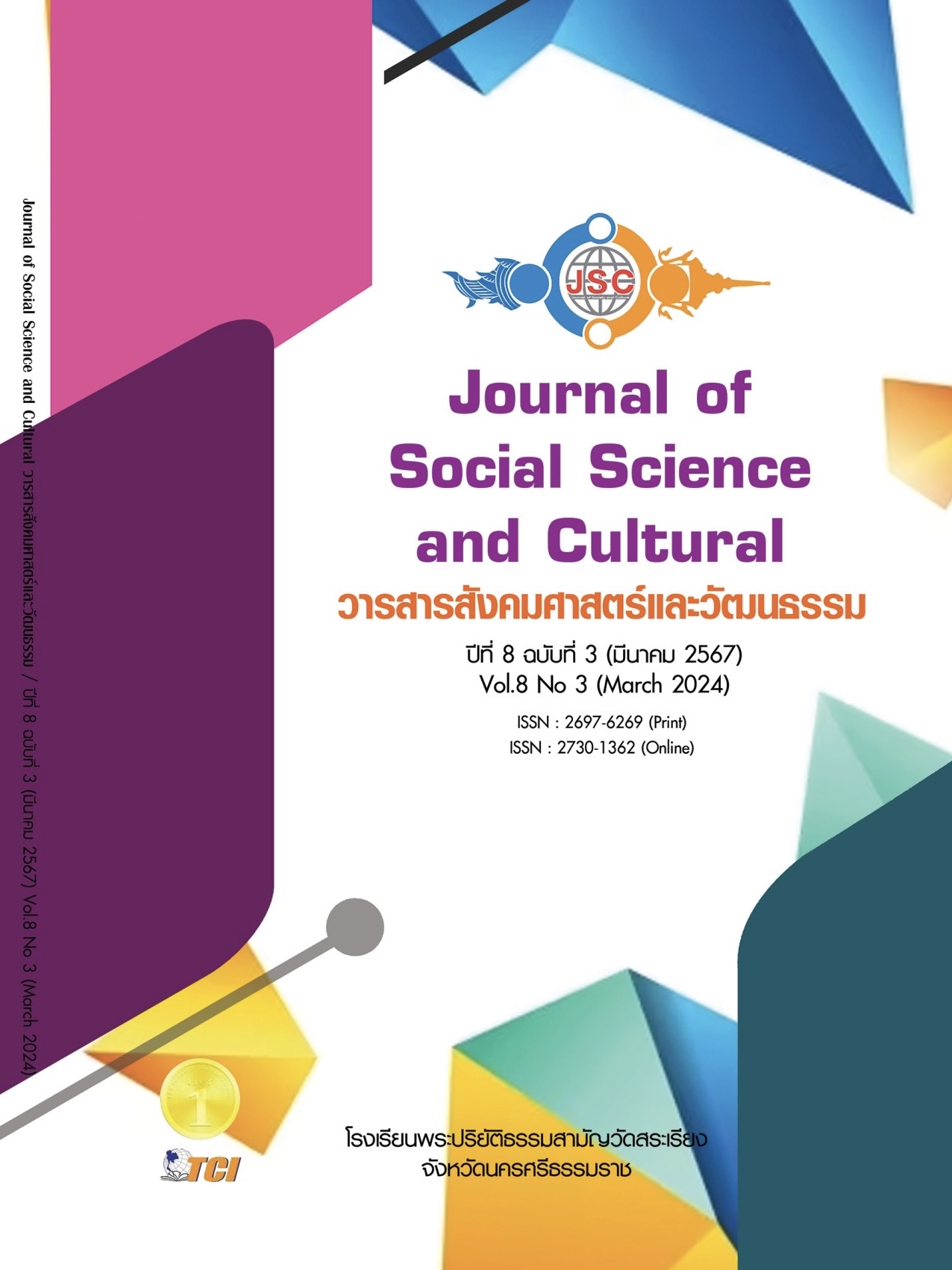CAUSAL FACTORS AFFECTING CORONAVIRUS 2019 PREVENTION BEHAVIORS OF WORKING PEOPLE IN THE 6th REGIONAL HEALTH MINISTRY OF PUBLIC HEALTH
Main Article Content
Abstract
This research aims to study the causal factors affecting the COVID-19 prevention behaviors of the working-age population in Health Region 6 of the Ministry of Public Health. These factors include health literacy, motivation to prevent disease, and social support. The sample group consisted of individuals aged between 20 and 59 years who had been screened for COVID-19 risk, totaling 544 people, obtained through multi-stage random sampling. Researchers collected data via questionnaires, and statistical analyses were utilized, including percentages, mean percentages, standard deviations, and path analysis using the LISREL software. The research findings revealed that the developed causal factor model for COVID-19 prevention behavior was consistent and fitted well with the empirical data (χ2 = 236.48, df = 119, χ2/df = 1.987, p = 0.00, CFI = 1.00, GFI = 0.96, AGFI = 0.93, TLI = 1.00, NFI = 1.00, RMSEA = 0.043, RMR = 0.011). Health literacy (r2 = 0.39) and motivation to prevent disease (r2 = 0.54) had a significant direct influence on COVID-19 prevention behavior (r2 = 0.78) at the 0.01 level of significance, and together they could explain 78.0% of the variance in COVID-19 prevention behavior. Policymakers can use the results of this research to formulate policies that promote COVID-19 prevention behavior, focusing on health literacy, enhancing motivation to prevent disease and social support. It encourages the involvement of public health officials in community-participatory work, allowing the working-age population to fully participate in health promotion activities within a management system by linking with community networks.
Article Details
References
กรมควบคุมโรค กระทรวงสาธารณสุข. (2564). แนวทางปฏิบัติเพื่อการป้องกันโรคติดเชื้อไวรัสโคโรนา 2019 (COVID-19) สำหรับประชาชนทั่วไปและกลุ่มเสี่ยง. เรียกใช้เมื่อ 28 สิงหาคม 2564 จาก https://ddc.moph.go.th/
ชญานิศ ศุภนิกร และคณะ. (2562). โปรแกรมการประยุกต์ทฤษฎีแรงจูงใจในการป้องกันโรคเพื่อส่งเสริมพฤติกรรมชะลอการเสื่อมของไตเรื้อรังระยะที่ 3 ในชุมชน. วารสารพยาบาล กระทรวงสาธารณสุข, 7(1), 1-14.
ตวงพร กตัญญุตานนท์ และคณะ. (2564). ปัจจัยที่มีความสัมพันธ์กับพฤติกรรมการป้องกันโควิด-19 ของนักศึกษาวิทยาศาสตร์สุขภาพ มหาวิทยาลัยหัวเฉียวเฉลิมพระเกียรติ. วารสารวิทยาศาสตร์และเทคโนโลยีมหาลัยหัวเฉียวเฉลิมพระเกียรติ, 7(1), มกราคม-มิถุนายน.
นงณภัทร รุ่งเนย เเละคณะ. (2564). ปัจจัยทำนายพฤติกรรมการเฝ้าระวังและป้องกันการติดเชื้อโรคโควิด-19 ของนักศึกษาพยาบาล. วารสารมหาวิทยาลัยนราธิวาสราชนครินทร์, 14(2), 17-37.
ปราณี ภาโสม. (2564). ความรอบรู้ด้านสุขภาพและพฤติกรรมการป้องกันโรคติดเชื้อไวรัสโคโรนา 2019 ของผู้มารับบริการคลินิกผู้ป่วยนอก โรงพยาบาลสกลนคร. ใน รายงานการวิจัย. กลุ่มงานสุขศึกษา โรงพยาบาลสกลนคร.
พรทิวา คงคุณ และคณะ. (2564). ความสัมพันธ์ระหว่างการรับรู้และการสนับสนุนทางสังคมกับพฤติกรรมการดำเนินชีวิตแบบวิถีใหม่เพื่อการป้องกันโรคติดเชื้อไวรัสโคโรนา 2019 ของผู้จำหน่ายอาหาร จังหวัดนราธิวาส. The Southern College Network Journal of Nursing and Public Health, 8(3), 133-146.
ส่วนบริหารและพัฒนาเทคโนโลยีการทะเบียน สำนักบริหารการทะเบียน กรมการปกครอง. (2565). ระบบสถิติทางการทะเบียน. เรียกใช้เมื่อ 10 มีนาคม 2565 จาก https://stat.bora.dopa.go.th/
สำนักงานกองทุนสนับสนุนการสร้างเสริมสุขภาพ. (2565). ความหมายนวัตกรรมสร้างเสริมสุขภาพ. เรียกใช้เมื่อ 10 ตุลาคม 2565 จาก https://www.thaihealth.or.th
สำนักงานสาธารณสุขเขตสุขภาพที่ 6. (2563). เอกสารสรุปผลการดำเนินงานเขตสุขภาพที่ 6 ปีงบประมาณ พ.ศ. 2563. เรียกใช้เมื่อ 10 มีนาคม 2565 จาก http://region6.cbo.moph.go.th
สำนักงานสาธารณสุขจังหวัดสมุทรปราการ. (2564). รายงานสถานการณ์โรคติดเชื้อไวรัส โคโรนา 2019 (COVID-19) ในจังหวัดสมุทรปราการ. เรียกใช้เมื่อ 2 กันยายน 2564 จาก http://www.spko.mop.go.th
องค์การอนามัยโลก. (1998). นิยามศัพท์ส่งเสริมสุขภาพ ฉบับปรับปรุงใหม่.(พิมพ์ครั้งที่ 3). กรุงเทพมหานคร: สถาบันวิจัยระบบสาธารณสุข.
Bloom, B. S. (1971). Handbook on formative and summative evaluation of student learning. New York: McGraw-Hill Book Company.
Hair, J. F.et al. (2010). Multivariate Data Analysis (7 th ed.). Upper Saddle River, NJ: Pearson Prentice Hall.
House, J. S. (1981). Measures and concepts of social support: Social supportand health. Florida: Academic Press.
Nutbeam, D. (2000). Health Literacy as a public health goal: a challenge for contemporary health education and communication strategies into the 21st century. Health Promotion international, 15(3), 259-267.
Roger, R.W. (1986). Protection Motivation Theory. Health Education Research Theory and Practice, 1(1986), 153–161.
Rogers, R. W. (1975). A protection motivation theory of fear appeals and attitude change. Journal of Psychology, 91(1), 93-114.
World Health Organization (WHO). (2020). Coronavirus (COVID-19) Dashboard Measures. Retrieved May 7 , 2023, from https://covid19.who.int/measures


